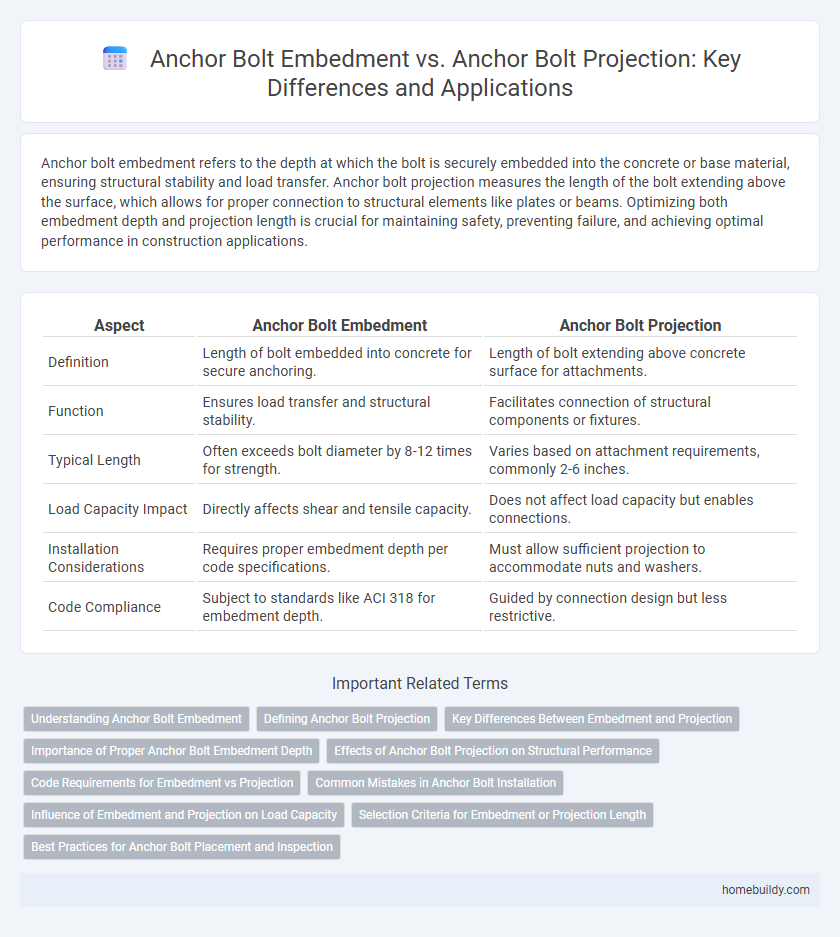Anchor bolt embedment refers to the depth at which the bolt is securely embedded into the concrete or base material, ensuring structural stability and load transfer. Anchor bolt projection measures the length of the bolt extending above the surface, which allows for proper connection to structural elements like plates or beams. Optimizing both embedment depth and projection length is crucial for maintaining safety, preventing failure, and achieving optimal performance in construction applications.
Table of Comparison
| Aspect | Anchor Bolt Embedment | Anchor Bolt Projection |
|---|---|---|
| Definition | Length of bolt embedded into concrete for secure anchoring. | Length of bolt extending above concrete surface for attachments. |
| Function | Ensures load transfer and structural stability. | Facilitates connection of structural components or fixtures. |
| Typical Length | Often exceeds bolt diameter by 8-12 times for strength. | Varies based on attachment requirements, commonly 2-6 inches. |
| Load Capacity Impact | Directly affects shear and tensile capacity. | Does not affect load capacity but enables connections. |
| Installation Considerations | Requires proper embedment depth per code specifications. | Must allow sufficient projection to accommodate nuts and washers. |
| Code Compliance | Subject to standards like ACI 318 for embedment depth. | Guided by connection design but less restrictive. |
Understanding Anchor Bolt Embedment
Anchor bolt embedment refers to the depth at which the bolt is set into the concrete, ensuring a secure bond that resists pullout and shear forces. Proper embedment depth is critical for structural stability, with factors such as concrete strength, bolt diameter, and load type influencing the required depth. Understanding anchor bolt embedment helps optimize design specifications, improve load transfer efficiency, and prevent structural failures.
Defining Anchor Bolt Projection
Anchor bolt projection refers to the length of the anchor bolt that extends above the concrete surface, used for attaching structural elements or machinery. Properly defining anchor bolt projection ensures sufficient engagement for secure connections without interference or obstruction. Accurate measurement of projection is critical for structural integrity and alignment during installation.
Key Differences Between Embedment and Projection
Anchor bolt embedment refers to the depth at which the bolt is embedded into the concrete, providing structural anchorage and load transfer capacity, while anchor bolt projection is the length of the bolt extending above the surface for attaching structural elements. Embedment depth is critical for achieving the required pull-out strength and resisting shear forces, whereas projection length ensures proper engagement with nuts, washers, and connected materials. The key difference lies in embedment securing the bolt within the substrate, whereas projection facilitates connection and assembly above the concrete surface.
Importance of Proper Anchor Bolt Embedment Depth
Proper anchor bolt embedment depth is critical for ensuring structural stability and load transfer between the anchor bolt and the concrete substrate. Insufficient embedment depth can lead to premature failure due to inadequate bond strength and reduced load capacity. Achieving the correct embedment depth maximizes resistance against shear, tension, and pullout forces, maintaining the integrity of anchored assemblies in construction applications.
Effects of Anchor Bolt Projection on Structural Performance
Anchor bolt projection significantly influences the load transfer capacity and stability of anchorage systems in concrete structures. Insufficient projection can reduce effective embedment depth, leading to decreased pullout strength and compromised resistance to tension and shear forces. Optimal anchor bolt projection ensures proper engagement with connected elements, enhancing overall structural performance and durability.
Code Requirements for Embedment vs Projection
Anchor bolt embedment depth is governed by building codes to ensure sufficient load transfer to the concrete foundation, with minimum embedment lengths specified based on bolt diameter and concrete strength. Projection length above the foundation slab must comply with code limits to allow proper fixture attachment without compromising structural integrity or safety margins. Codes such as AISC and ACI detail precise tolerances for both embedment and projection to optimize anchorage performance and prevent failure during service.
Common Mistakes in Anchor Bolt Installation
Common mistakes in anchor bolt installation often involve confusing embedment depth with anchor bolt projection. Insufficient embedment depth compromises the bolt's load capacity and structural stability, while excessive projection can interfere with connected components and reduce effective grip. Proper understanding and adherence to specified embedment and projection dimensions ensure optimal performance and safety of anchor bolt installations.
Influence of Embedment and Projection on Load Capacity
Anchor bolt embedment depth directly influences load capacity by increasing the resistance to pullout and shear forces within the concrete substrate. Anchor bolt projection length affects the effective transfer of load by providing sufficient engagement for nuts and washers, ensuring proper clamping and preventing slippage. Optimizing both embedment and projection dimensions is critical to achieve the required structural performance and safety margins.
Selection Criteria for Embedment or Projection Length
Selecting the appropriate anchor bolt embedment or projection length depends on factors such as the load type, concrete strength, and structural requirements. Embedment length must ensure sufficient adhesive and mechanical interlock to resist tension and shear forces, while projection length should accommodate base plate thickness and allow proper nut and washer engagement for secure fastening. Evaluating these criteria ensures anchor bolts achieve optimal load transfer and structural stability.
Best Practices for Anchor Bolt Placement and Inspection
Proper anchor bolt embedment ensures structural stability by maximizing load transfer within concrete, while correct projection height allows secure connection to structural elements. Best practices for anchor bolt placement include verifying embedment depth to meet design specifications and maintaining consistent projection to avoid misalignment during installation. Regular inspection with calibrated measurement tools guarantees compliance with engineering standards, preventing potential structural failures.
anchor bolt embedment vs anchor bolt projection Infographic

 homebuildy.com
homebuildy.com